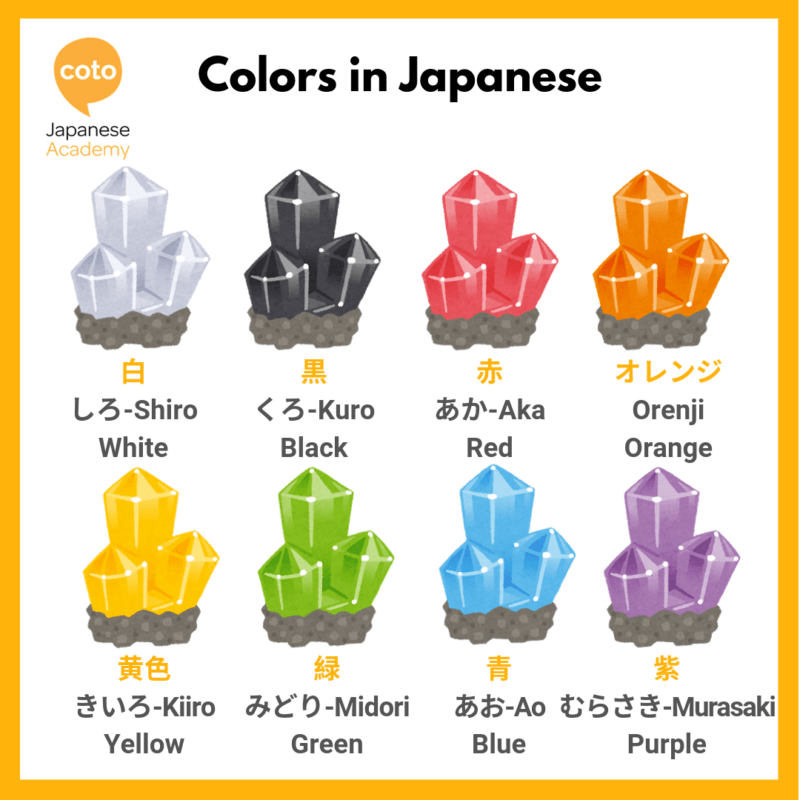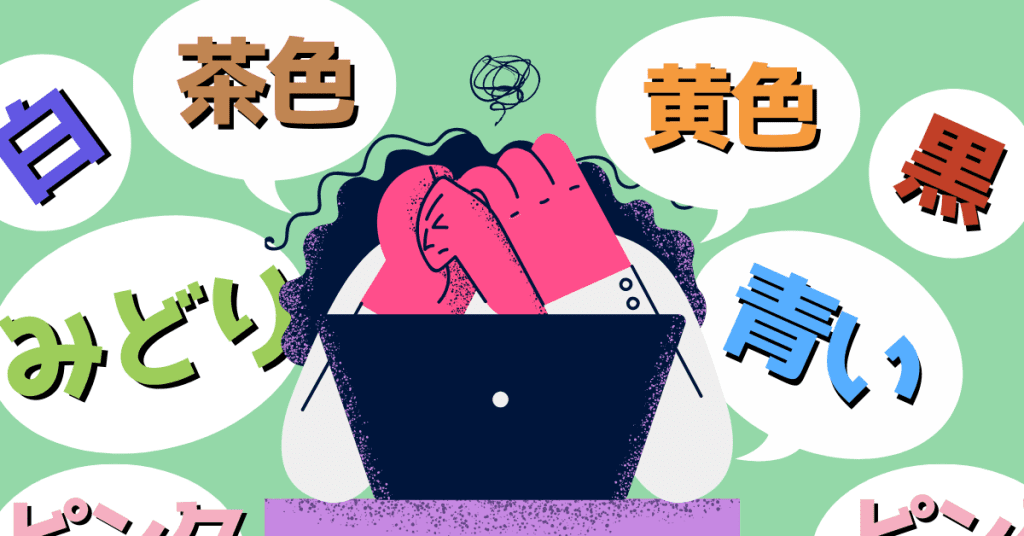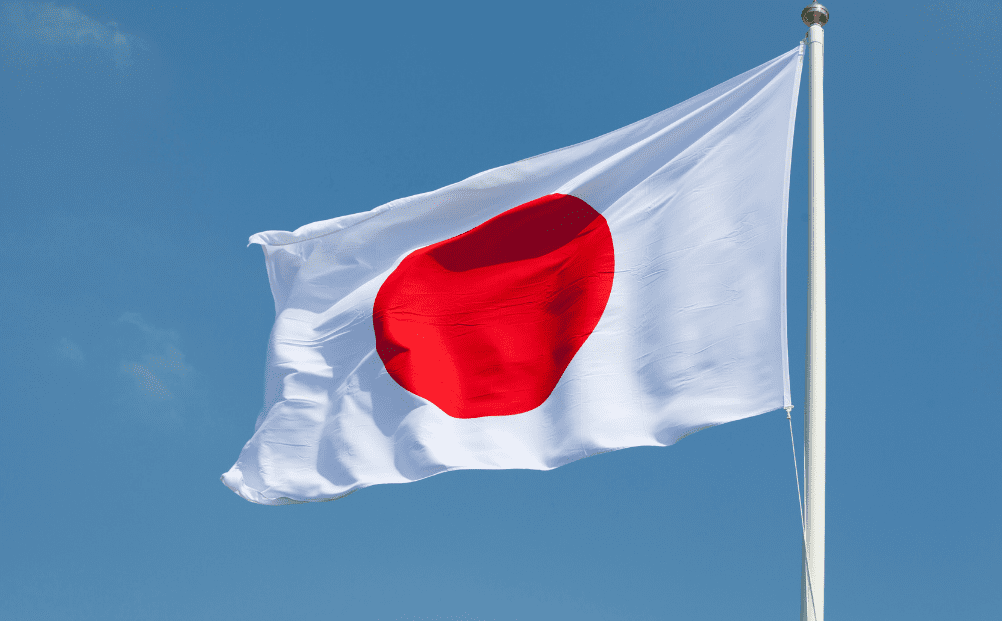How To Say Orange In Japanese

Primary colors in Japanese seem easy and straightforward, but you'd exist surprised by how much civilization and history go behind them. Granted, a lot of Japanese vocabulary is borrowed from English language, which makes it easy for the states to memorize them — but in Japanese culture, colors take an important part if representing feelings, rituals and ceremonies.
In Japanese, the words for specific colors are used differently depending on their parts of speech. Having two sets – one ready is the Japanese – the other being a katakana loan discussion version of their In that location are two ways: one gear up is the Japanese one, and the other is a katakana loan give-and-take version of their English counterparts. Most colors in Japanese finish with 色 except for a few exceptions and words borrowed from English.
For case, the colour "blueish" can be both 青い (aoi) and ブルー (buruu).
Another example is the color orange. Even Japanese people volition often opt for the loanword, オレンジ, instead of using the traditional Japanese word: 橙色 (daidaiiro).
This can be very confusing for beginners in Japanese as to what context is appropriate to apply which version. In this article, we will explain to you how to describe objects with colors in Japanese.
Click here to join our 30 24-hour interval challenge to acquire hiragana!
Bound to:
- Nouns for Bones Colors in Japanese
- Japanese Colors as Describing word
- A Cursory Guide (or History) on Japanese Color
- Confusion Around Colors in Japanese
- Meanings of Colors in Japanese Civilization
- How to Say Other Colors in Japanese

Nouns for Basic Colors in Japanese
| English | Japanese | Furigana | Romaji | Katakana | Romaji |
| Scarlet | 赤 | あか | Aka | レッド | Reddo |
| Orange | 橙色 | だいだいいろ | Daidaiiro | オレンジ | Orenji |
| Yellow | 黄色 | きいろ | Kiiro | イエロー | Ieroo |
| Green | 緑 | みどり | Midori | グリーン | Guriin |
| Blue | 青 | あお | Ao | ブルー | Buruu |
| Royal | 紫 | むらさき | Murasaki | パープル | Paapuru |
| Pink | 桃色 | ももいろ | Momoiro | ピンク | Pinku |
| Chocolate-brown | 茶色 | ちゃいろ | Chairo | ブラウン | Buraun |
| Greyness | 灰色 | はいいろ | Haiiro | グレイ | Gurei |
| Black | 黒 | くろ | Kuro | ブラック | Purakku |
| White | 白 | しろ | Shiro | ホワイト | Howaito |
These words to a higher place are nouns that refer to dissimilar colors. Every bit a result, the particle "の(no)" is used when describing the color of something. If you are not familiar with particles in Japanese, nosotros recommend you to have a look at our basic Japanese grammer guide.
The basic judgement pattern for describing colors is color + の + subject.
For example:
みどりの窓口(まどぐち)
Midori no madoguchi
Green window (usually referring to the ticket part at a railroad train station in Japan)
紫(むらさき)の靴下(くつした)
Murasaki no kutsushita
Purple socks.
Why do we apply の instead of な? For the reply, head to our article on the dilemma of な-adjectives and の-adjectives.
Japanese Colors as Adjectives
Color can also be used as adjectives. Surprisingly, there are only iv colors that will go an adjective when "い" is added directly to the back.
| English | Japanese | Furigana | Romaji |
| Blood-red | 赤い | あかい | Akai |
| Bluish | 青い | あおい | Aoi |
| Black | 黒い | くろい | Kuroi |
| White | 白い | しろい | Shiroi |
To use Japanese colors equally adjectives, yous tin can apply them directly in front of a subject. For example:
あおい海(うみ)
Aoi umi
Blue sea
海(うみ)はあおいです。
Umi wa aoi desu
The ocean is blue.
Check out: Beginner's Guide to Japanese Adjectives: な and い Adjectives
A Brief Guide on Japanese Colors
So why only 4, and why are these colors special? It is because only four colors existed as the basic forms of colour in the aboriginal Japanese linguistic communication — or, at least, acknowledged: 白 shiro (white), 黒kuro(black), 赤aka (blood-red) and 青ao (blueish).
The same can be seen in other basic color wheels. Kuro (くろ) and shiro (しろ) are used to depict things that are night and low-cal — cool and warm. The give-and-take あか covers a spectrum of night red, orange and xanthous, with lighter yellow colors grouped to しろ. Ki (黄) paints in shades of xanthous, gold and lighter brown. Murasaki (むらさき) was once a name of a establish but eventually became a color name for purple, too.
Rather than actual colors, these words are used to grouping particular hues and shades. For example, different shades of blue in the by are at present imperial, grayness and green.

Confusions Around Colors in Japanese
We're non trying to make things complicated, just if y'all dig deeper into the Japanese language, you lot'll find that colors in Japanese aren't as "innocent" as they seem. Have a look at some of the few language conundrums.
"黄色い" and "茶色い"
At that place are two more colors that tin become Japanese adjectives: 黄色 (kiiro) and 茶色 (chairo). You might call back: they are formatted exactly the same style as other (native Japanese) colors, so why didn't nosotros not put them together with the four main colors higher up? This is considering although meaning yellow and brown color, "黄" and "茶" cannot exist on themselves when used every bit colors.
In fact, the Japanese discussion for 茶 (cha) means tea.They have to be put together with the discussion "色 (iro colors) to go nouns for yellow and brown. Every bit a result, when they become adjectives, they are "黄色い" and "茶色い" instead "黄い" or "茶い"
Blueish and Green: 青い
In the past, Japanese people considered blueish and green every bit one color called 青い. Considering there was no seperation between the two until recently, even in mod times, the word "aoi" is still used to depict objects that are green, like green apples (青りんご) or green traffic lights (青信号).
The Japanese language only got its unique give-and-take for green, みどり (緑) during the Heian period, which was between 794 and 1185. Even so, the term was not widely adopted until later World War II, and its tardily adoption was partly why we still see あおい used to describe things that are green.
To learn more nearly the differences and fun historical facts, bank check out our exploration on the divergence betwixt aoi and midori!

Meanings of Colors in Japanese Culture
A lot of countries (and cultures) place importance on colors. While each tradition may not have the same ideals, specific colors more often than not represent positive or negative symbols. Depending on the pregnant it represents, people might steer clear of wearing that color at a certain result — or, on the contrary, feel inclined to article of clothing them.
Symbolism in Japanese colors is heavily rooted in China and its traditional philosophies, which include Buddhism, Taoism and Confucianism. In the past, these philosophies affected the association of color with each social class of Japanese social club.
In other words, colors correspond the values of life, particularly white, red, black and blue — the four primary colors in Japanese culture. This is why you'll see that well-nigh Japanese clothing, architecture and events incorporate them.
Significant of White Color in Japanese Culture
White (白い)zztakes the bulk of the Japanese flag — and for an important reason. As the color of the gods, it represents purity, both spiritual and concrete, and reverence for divinity. In Buddhism, white was worn at funerals as it likewise means decease, and funerals were often marked with white and black stripes.
However, information technology was the focus of Shinto traditions (check out Japanese religion vocabulary here). Y'all'll notice white sand, pebbles and decorations at shrines to honor the gods' wisdom and cognition. Emperors in Japan would be dressed in white for Shinto rituals, and brides would be covered in white apparel and head roofing for their wedding.
Meaning of Cherry Color in Japanese Civilization
The focal point of the Japanese national flag, red (赤い) symbolizes authority, strength and prosperity. This is why it is especially symbolic when paired with white.
In fact, crimson plays a ascendant role in Japanese architecture. Yous'll notice shrines and temples are painted in carmine, every bit it is likewise believed the color can ward away evil spirits while strengthening the link between humans and gods in Shinto shrines. At festivals, people would cover the tables and floor with red textile and carpets.
Meaning of Black Colour in Japanese Culture
Earlier Western influence, black (黒い) wasn't always the colour for mourning, but it did have a somewhat negative association. While purple represented the highest rank in the Japanese social class (royalty), blackness marked the lowest of them. The night shade was tied to evil, bad luck, fear and misfortune.
Significant of Blue Colour in Japanese Culture
Blue dye, fabricated from the indigo plant, was the most accessible (and affordable) color Japanese people could employ to make clothing and textiles. As such, blue ( 青い)is the color of common people, worn on kimonos, formal attire and common wear.
How to Say Other Colors In Japanese
If y'all feel that the basic colors are too general, hither are some Japanese words for more than specific colors.
| English language | Japanese | Furigana | Romaji | Westernized | Romaji |
| Silver | 銀 | ぎん | Gin | シルバー | Shirubaa |
| Gold | 金 | きん | Kin | ゴールド | Goorudo |
| Rainbow clour | 虹色 | にじいろ | Nijiiro | ||
| Light Blue | 水色 | みずいろ | Mizuiro | ||
| Navy Blue | 紺色 | こんいろ | Koniro | ネービー | Neiibi |
| Royal | 紫 | むらさき | Murasaki | パープル | Paapuru |
| Yellow Green | 黄緑 | きみどり | Kimidori | ||
| Beige | ベージュ | Beeju |
Want to learn more than merely colors? Bank check out our Japanese courses!
Coto Japanese Academy offers relaxed and fun conversational lessons for all levels of Japanese learners.
Arrive touch with us and permit u.s. know how we can help yous achieve your Japanese language target. If you're unsure where you are, nosotros provide a complimentary Japanese level bank check.
Source: https://cotoacademy.com/colors-japanese-use-japanese-color-words/

0 Response to "How To Say Orange In Japanese"
Post a Comment